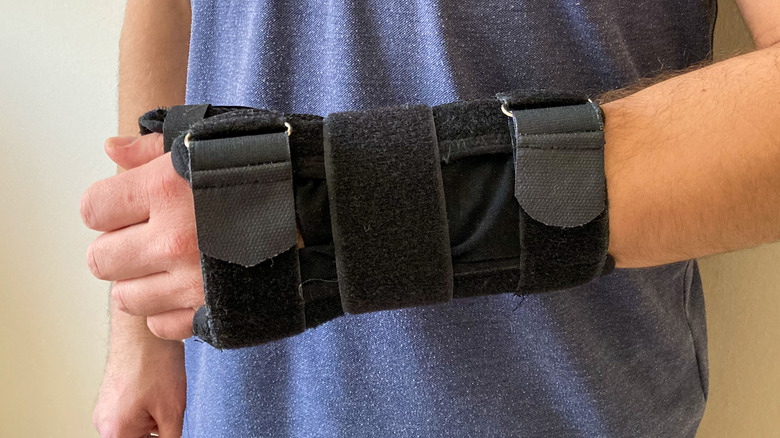What Does It Mean When Your Left Wrist Hurts
For a part of the body that is used every single day, having pain in your wrists and hands can be concerning. And if your wrists are under regular, repetitive strain from what you do for a living, or even just mundane tasks like housework or exercise, a small wave of discomfort has the potential to develop into something more painful if not treated properly. So what does it mean when your left wrist hurts?
While there's not much to differentiate between left and right wrist pain, the cause of it can be easy to spot. Pain in the wrist is often attributed to Repetitive Strain Injury (RSI), which is related to the overuse of muscles and tendons in specific areas of the body, according to the U.K.'s National Health Service (NHS). This can be the result of jobs that involve repeated movements, like typing or assembly line tasks, poor posture, or high-intensity activities. Symptoms of RSI include pain, aching, or tenderness, weakness, cramps, throbbing, and tingling or numbness.
Wrist pain is most often caused by repetitive movements from work or hobbies
Repetitive motion in the wrist can also put you at risk of developing Carpal Tunnel Syndrome (CTS). Somewhat similar in symptoms to RSI, this condition occurs when too much pressure is put on the median nerve in your wrist. This is one of the main nerves into your hand, which provides feeling to your thumb, index, and middle fingers (via Cleveland Clinic). Enough pressure on this nerve can cut off the sensation to your hands and fingers, which is the most common symptom.
The median nerve sits within the carpal tunnel, which also houses tendons that connect muscles in the forearm to the bones in your hand. Unlike RSI, you can develop CTS from many factors, including your family history, arthritic diseases, hypothyroidism, and even pregnancy.
Another condition with a similar root cause (i.e. repetitive motion) is De Quervain's Tensosynovitis. Named after the surgeon who discovered it in the late 1800s (via Geisinger), this condition is more localized to the "thumb side" of your wrist, and results in pain whenever you attempt to grab things or make a fist. According to the Mayo Clinic, the exact cause of this condition isn't known, but it's most likely caused by repetitive activities like gardening, playing sports, or even lifting a baby.
What you should do if your symptoms get worse or continue to persist
Whatever pain you may be feeling in your wrist, if it persists for more than a couple of weeks it's recommended to get it checked out by a doctor, especially if the pain gets drastically worse and keeps coming back (via NHS). They might be able to rule out anything more serious, and professional insights will aid in preventing future injuries to the affected area.
This often results in being given protective medical equipment like splints to keep your wrist straight and supported (via Verywell Health) or even ergonomic items to add to the office, like keyboard and mouse mat rests (via New York Magazine). If you don't feel as though you need to see a doctor, you can probably find these online or at your local pharmacy.
You'll most likely be prescribed with an anti-inflammatory or pain relieving drug such as paracetamol (acetaminophen) or ibuprofen. You can ease wrist pain yourself by doing the same thing, but the NHS recommends not to take ibuprofen within the first two days of an injury, and instead stick only to acetaminophen.


